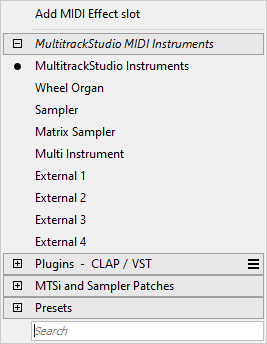MIDI Instruments
MIDI Instruments are used to convert MIDI messages to audio. These instruments are available:- MultitrackStudio Instruments, a GM compatible instrument collection.
- Wheel Organ, emulates a tonewheel organ.
- SoundFont Player, generates audio using .sf2 files. (Mac only)
- Sampler, generates audio using samples.
- Matrix Sampler, plays back samples.
- Multi Instrument, can contain multiple instruments.
- External MIDI Instruments, can be either an external hardware synth, a synth on your soundcard, or a software emulation of such a device.
- AU Instrument Plugins, AU plugins that can convert MIDI to audio.
- CLAP Instrument Plugins, CLAP plugins that can convert MIDI to audio.
- VST Instrument Plugins, VST plugins that can convert MIDI to audio.
 |
 |
MIDI Instruments are used in Instrument Slots. An instrument slot appears on any track containing a MIDI file, replacing the left hand effect slot. Instruments can be selected by clicking the slot's down arrow (or by right-clicking the slot).
The Instrument Selector contains all built-in MultitrackStudio instruments, AU / CLAP / VST plugins, sampler patches, and instrument presets. The Plugins option's ☰ button (on the right) provides access to the Plugin Manager.
Clicking the slot's button will show the instrument's user interface. When this window appears the instrument will be "live", so it responds to your MIDI keyboard. The instrument will also be live while the track's Rec button is engaged.
All instruments feature a red indicator on the right hand side that lights up when the instrument is currently responding to messages received from the MIDI In Device (i.e., your MIDI keyboard). If a "buffer error" occurs due to CPU usage being too high while the Transport is not running, the instrument will be deactivated. If this happens, the instrument can be reactivated by either hiding and showing its user interface or reactivating the track's Rec button.
Instruments can be copied from one instrument slot to another using drag-and-drop.
Search
A search text can be typed to filter the Instrument Selector. AU / CLAP / VST list items have invisible tags so you can use "au", "clap", or "vst" search terms to hide the other types of plugins. The items in the MTSi and Sampler Patches section have invisible "mtsi" and "sampler" tags.While an instrument's user interface is visible you can press the F3 key (Windows) / Option-Command-F (Mac) to pop up the Instrument Selector. It remembers the search text, so you can try the next instrument that matches the search text easily.
Presets
Presets can be loaded or created using the Presets button which appears on the instrument's user interface. Instrument presets can optionally include the audio and MIDI effects in the track.
Note Names
Each instrument window has an option to override the note names, accessible via the ☰ button. These note names appear in the Drum Editor.Articulations
Articulations can be defined so you can use multiple articulations of an instrument in a single track. Bowed and pizzicato violin, for example. See Articulations.Using software instruments in record mode
Real-time audio processing on a computer involves a trade-off between latency and reliability. MultitrackStudio is designed for high reliability in order to minimize the chance of glitches. The downside of this approach is fairly high latency (usually slightly more than 0.5 seconds). This means it takes about half a second before you hear the effect of moving a Volume fader or any other control.
Obviously, playing a MIDI keyboard would be impossible with such a high latency between playing and hearing the actual sound. Therefore, MultitrackStudio takes a different approach when recording using a software instrument. The output of tracks containing software instruments is not routed through the mixer, but directly to the Audio Out Device instead. The track's Effect Sends and Output Bus Selector are not available in this situation.
The software instrument latency can be set in the Studio menu's Devices window.
"Freezing" software instruments
MIDI tracks using a software instrument can be saved to an audio file using the track's Save As option. This can be useful if a software instrument uses a lot of CPU power. The software instrument is effectively replaced by an audio file, but all effects and mixer settings remain the same, so the sound is identical. The track's File Options Menu can be used to load the MIDI file again (it appears in the File History at the bottom of the menu). The software instrument will be reloaded automatically. This feature is commonly called "freeze".
A software instrument's output level could be too high for an audio file, causing the signal to clip. If this happens, you can use the MIDI track's Controller Editor to turn down the Volume or Expression controllers. Pro edition users can use 32-bit float .wav files. These files do not clip the audio signal, so the problem won't occur.